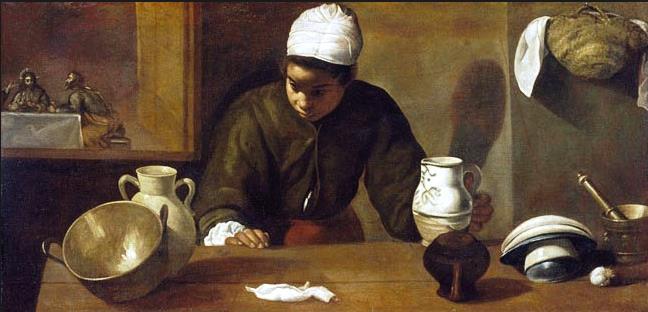Denise Levertov & Diego Velazquez
Diego Velazquez: The Servant Girl at Emmaus

The Servant Girl at Emmaus (A Painting by Velazquez)
by Denise Levertov
She listens, listens, holding
her breath. Surely that voice
is his—the one
who had looked at her, once, across the crowd,
as no one ever had looked?
Had seen her? Had spoken as if to her?
Surely those hands were his,
taking the platter of bread from hers just now?
Hands he'd laid on the dying and made them well?
Surely that face—?
The man they'd crucified for sedition and blasphemy.
The man whose body disappeared from its tomb.
The man it was rumored now some women had seen this morning, alive?
Those who had brought this stranger home to their table
don't recognize yet with whom they sit.
But she in the kitchen, absently touching
the winejug she's to take in,
a young Black servant intently listening,
swings round and sees
the light around him
and is sure.
*******
Diego Velazquez: The Servant Girl at Emmaus, c. 1617-1618, oil on canvas, 55 x 118 cm.
Diego Velazquez was a 17th century Spanish painter. He was born in 1599 in Seville, Spain. Although his early paintings were religious-themed, he became renowned for his realistic, complex portraits as a member of King Philip IV's court. In his later years, the Spanish master produced a renowned portrait of Pope Innocent X and the famed Las Meninas. He died on August 6, 1660 in Madrid.
Denise Levertov was born in England to a Welsh mother and a Russian Hasidic father. Her father, who had emigrated to the UK from Leipzig, converted to Christianity and became an Anglican priest. She moved to the United States in 1948, and in 1955 became an American citizen. By the time she died in 1997, Levertov had published nearly fifty volumes of poetry, prose, and translations. Levertov taught at Brandeis, MIT, Tufts, Stanford, and the University of Washington. It was at Stanford, where she taught for 11 years (1982–1993) in the Stegner Fellowship program, and where her papers are now housed, that Levertov converted to Christianity at the age of sixty. After moving to Seattle in 1989, she joined the Catholic Church.
For Levertov's poetry, see Paul A. Lacey and Anne Dewey (editors), with an Introduction by Eavan Boland, The Collected Poems of Denise Levertov (New York: New Directions, 2013), 1063pp.






